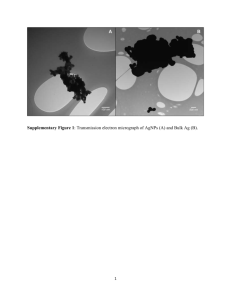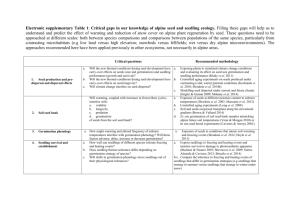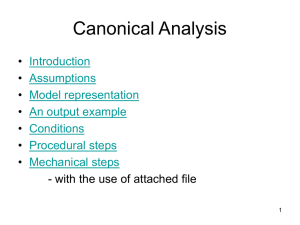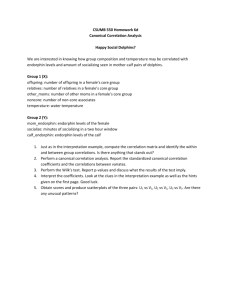Evaluation of seedling characteristics of wheat
advertisement
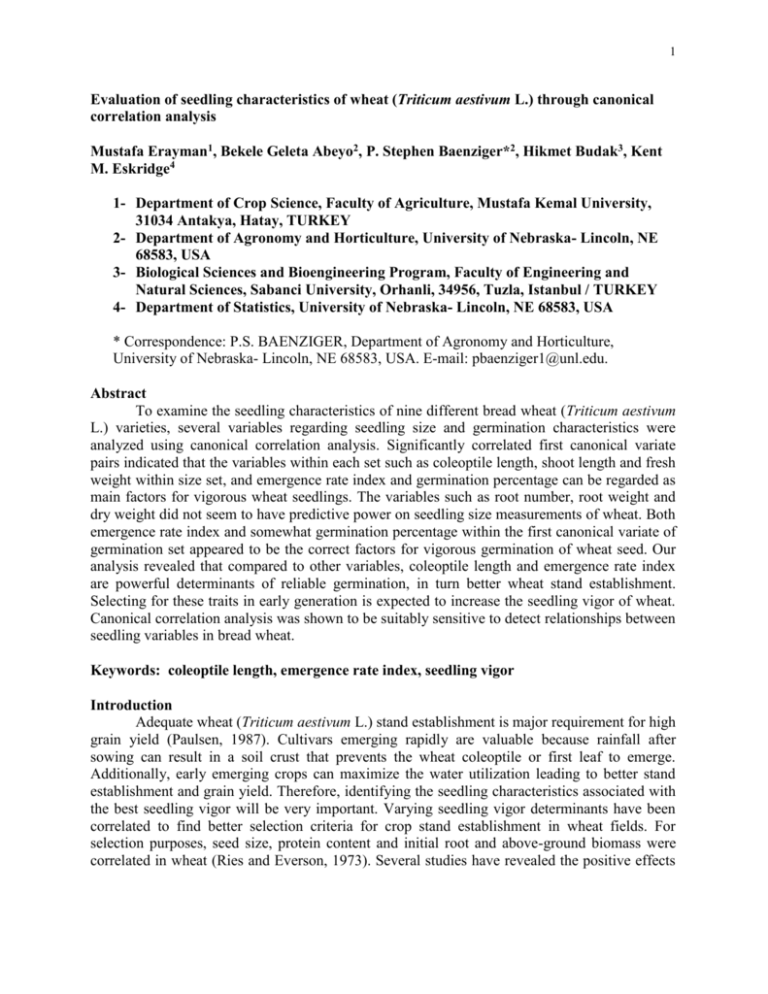
1 Evaluation of seedling characteristics of wheat (Triticum aestivum L.) through canonical correlation analysis Mustafa Erayman1, Bekele Geleta Abeyo2, P. Stephen Baenziger*2, Hikmet Budak3, Kent M. Eskridge4 1- Department of Crop Science, Faculty of Agriculture, Mustafa Kemal University, 31034 Antakya, Hatay, TURKEY 2- Department of Agronomy and Horticulture, University of Nebraska- Lincoln, NE 68583, USA 3- Biological Sciences and Bioengineering Program, Faculty of Engineering and Natural Sciences, Sabanci University, Orhanli, 34956, Tuzla, Istanbul / TURKEY 4- Department of Statistics, University of Nebraska- Lincoln, NE 68583, USA * Correspondence: P.S. BAENZIGER, Department of Agronomy and Horticulture, University of Nebraska- Lincoln, NE 68583, USA. E-mail: pbaenziger1@unl.edu. Abstract To examine the seedling characteristics of nine different bread wheat (Triticum aestivum L.) varieties, several variables regarding seedling size and germination characteristics were analyzed using canonical correlation analysis. Significantly correlated first canonical variate pairs indicated that the variables within each set such as coleoptile length, shoot length and fresh weight within size set, and emergence rate index and germination percentage can be regarded as main factors for vigorous wheat seedlings. The variables such as root number, root weight and dry weight did not seem to have predictive power on seedling size measurements of wheat. Both emergence rate index and somewhat germination percentage within the first canonical variate of germination set appeared to be the correct factors for vigorous germination of wheat seed. Our analysis revealed that compared to other variables, coleoptile length and emergence rate index are powerful determinants of reliable germination, in turn better wheat stand establishment. Selecting for these traits in early generation is expected to increase the seedling vigor of wheat. Canonical correlation analysis was shown to be suitably sensitive to detect relationships between seedling variables in bread wheat. Keywords: coleoptile length, emergence rate index, seedling vigor Introduction Adequate wheat (Triticum aestivum L.) stand establishment is major requirement for high grain yield (Paulsen, 1987). Cultivars emerging rapidly are valuable because rainfall after sowing can result in a soil crust that prevents the wheat coleoptile or first leaf to emerge. Additionally, early emerging crops can maximize the water utilization leading to better stand establishment and grain yield. Therefore, identifying the seedling characteristics associated with the best seedling vigor will be very important. Varying seedling vigor determinants have been correlated to find better selection criteria for crop stand establishment in wheat fields. For selection purposes, seed size, protein content and initial root and above-ground biomass were correlated in wheat (Ries and Everson, 1973). Several studies have revealed the positive effects 2 of larger seed size on wheat germination and establishment (Singh, 1970; Ries and Everson, 1973; Hampton, 1981; Kalakanavar et al., 1989; Aparicio et al., 2002). Another essential seedling trait useful to improve wheat stand establishment is length of coleoptile, which is a protective sheath encasing shoot during emergence. Coleoptile length (CL) is of great importance when considering variable seeding depth, soil surface temperature and moisture, which affect the coleoptile development, in turn seedling emergence and crop stand establishment. Coleoptile length is a highly heritable character and could be efficiently used in selection programs in early segregating generations (Hakizimana et al., 2000; Chowdry and Allan, 1963). Although the main variation in the coleoptile length is genetic (ICARDA, 1987), the trait was significantly affected by genotype x environment interaction (Hakizimana et al., 2000). Boyd, Gordon and Lacroix, (1971) considered germination capability and rate of germination as important factors in assessing seedling vigor. Emergence capability of winter wheat was also associated with coleoptile length and stand establishment (Schillinger et al., 1998). A positive association was reported between CL and winter wheat emergences indicating that CL affected total plant emergence (Burleigh et al., 1965; Sunderman 1964). Additionally, CL was found to be positively correlated with plant height indicating that shorter plants had shorter coleoptiles (Whan 1976; Hoff et al., 1973; Sunderman 1964) as would be expected since the reduced height genes that control plant height in semidwarf wheat also affect CL (Rebetzke et al. 2001; Ellis et al. 2005). Allan et al. (1962) also found a positive correlation between CL and emergence rate index. Several other seedling characteristics such as emergence percentage, emergence rate index, dry root and shoot, fresh root and shoot weights and lengths were correlated and found to be heritable seedling traits (Khan et al. 2002). The studies, which associated seedling vigor to other plant characteristics or germination properties, used either simple linear regression or correlation for their analyses (Schillinger et al., 1998; Rebetzke and Richards, 1999; Khan et al., 2002; Cisse and Ejeta, 2003). Simple correlation and even principal component analyses do not make the distinction between variables, namely, linear and multiple regression analyses allow only a single dependent variable. Canonical correlation analysis (CCA) is a multivariate linear statistical method used to describe the linear relationship between two sets of variables, and understand the multidimensional relations between these two sets of variables (Hotelling, 1936). Canonical correlation analysis was used for end-use quality variables of bread wheat (Butt et al., 2001), texture and sensory characteristics of different potato cultivars (Vainionpaa et al., 2000) and various other disciplines to analyze multidimentional relations between multiple dependent and multiple independent variables (Shafto et al., 1997). However, to our best knowledge canonical correlation analysis has not been used to investigate relationships between seedling and germination characteristics. Improved seedling response to adverse environmental conditions likely results in increased vigor of growing plants and increased yield. How seedling characteristics affect differences in early vigor among genotypes is not well understood. Therefore, the objectives of our study were; i) to examine factors that may contribute to wheat growth advantage which are the principal determinants of early seedling vigor in wheat, and ii) to investigate plant characteristics important for increased seedling vigor, which helps as selection criteria in the development of vigorous high yielding varieties. We used canonical correlation analysis to see how morphological characteristics were associated with the germination properties of wheat plants during seedling formation. 3 Materials and methods Plant material Nine wheat cultivars (Table 1) from diverse backgrounds that were widely grown in Nebraska were used in this study. Centura, Pronghorn, and Scout 66 were conventional height cultivars. Vista, Alliance, Arapahoe, Nekota, and Niobrara were semidwarf cultivars (most likely containing Rht1). Cougar has the phenotype of lines containing the Rht8 allele. All seed was derived from field grown plants in 1996. Table 1. The Pedigree /Cross and some agronomic traits of varieties released by University of Nebraska- Lincoln from 1966-1996. Name Pedigree /Cross Year released Ne68513/Ne68457//Centurk/3/Brule 1992 Vista 1993 Alliance Arkan/Colt//Chisholm sib Arapahoe Brule/3/Parker*4/Agent//Belot.198/3/Lancer 1988 Bennett/TAM107 1994 Nekota 1994 Niobrara TAM105*4/Amigo/Brule sel.5 1983 Centura Warrior*5/Agent//Ne68457/3/Centurk78 1996 Pronghorn Centura/Dawn//Colt sib. selection from scout 1966 Scout66 Thunderbird/NE87505 Cougar Ht(cm) Maturity Short med. med. med. med. tall tall tall med. med.-late med.med.-late med.med.med.-early med.-early med.-early Med.-early Growth system Thirty seeds of each variety with similar seed size were sown in a flat box (83 cm long by 10 cm wide and 15 cm depth) filled with moistened vermiculite at 2.5, 5.0, 7.5 or 10 cm depths and covered to the desired level after labeling. The boxes were watered and put in a dark growth chamber set at a constant temperature of 20 °C for 12 hr and 12.8 °C for 12 hr. A split plot design with two replications was used considering four planting depths as main plot and 9 bread wheat varieties as sub-plot. Continuous watering was done to maintain the required moisture for germination. Measurements Seedlings were counted when the shoots emerged. Two weeks after planting, 10 seedlings were removed, the vermiculite was washed away and CL, shoot length (SL), and root length (RL) were measured to the nearest millimeter and number (RN) was counted. In addition, fresh weights (FW) and dry weights (DW) of the sampled seedlings were taken. Means of the 10 seedlings were used for the analyses of CL, SL, RL, RN, FW and DW. Emergence rate index (ERI) was determined by counting daily the emerged shoots of 30 plants and multiplying the number of shoots, which emerged on the first day, by six, plus the 5 times the number of shoots emerged on the second day, and so on until multiplying the shoots, which emerged on the sixth 4 day, by one. Germination percentage (GP) was the number of germinated plants out of 30 seed. Following oven drying at 70 °C for 48 hours the dry weight was recorded for each variety. Statistical analyses Variety differences were analyzed using standard analysis of variance (ANOVA) and Duncan’s multiple range test procedures, and PROC GLM command was used for this purpose (SAS Institute, Inc., Cary, NC). Variance components were estimated from the expected mean squares (Comstock and Moll, 1963) and heritabilities of the dependent variables were estimated as a ratio of genotypic variance to phenotypic variance where the depth effects were removed by not including the depth variance component in the estimate of phenotypic variance (Fehr, 1983). Canonical correlation analysis, developed by Hotelling (1936), often allows a more meaningful interpretation of interrelations between variables than simple correlation and multiple regression analyses. Canonical correlation analysis utilizes 2 sets of variables and forms linear indices from each of the sets of variables so that the correlation between the two indices is maximized. Several pairs of linear indices are derived and are named canonical variates (Warwick, 1975). Specifically, the ith pair of canonical variate is described as: q p U a z i ij j and V b z i ij j , i = 1,2,3…p and j= 1,2,3, …q where q p, zj is the jth variable (standardized or not), p is the number of variables in the first set, q is the number of variables in the second set, aij and bij are the variable coefficients (or loadings) in the first and second sets, respectively. Because we were only interested in describing associations due to variability across genotypes, we generated a data matrix corrected for depth effect by subtracting the different sowing depth means from the original data. This resulted in 36 observations for each of the 8 variables. Using the variables corrected for depth was reasonable since depth x variety interaction was insignificant for all but one of the variables (Table 2). As basic inputs we utilized two sets of variables, one set was based on seedling morphology variables and the other was based on germination variables. Coleoptile length, SL, RL, RN, FW, and DW variables are related to morphology or size of the seedlings, therefore the set was named as “size”(Ui). Emergence rate index and GP constituted the “germination” (Vi) set. In order to determine the relationship between these two sets, we employed the canonical correlation analysis using PROC CANCORR command (SAS Institute, Inc., Cary, NC). Canonical correlation computations were performed on the correlation matrix, computed from the adjusted data matrix previously described from SAS Institute. Results and discussion Analyses of variance identified significant differences among genotypes for all the traits indicating there was considerable variation among genotypes (Table 2) as would be expected among diverse cultivars whose post-hoc comparisons for all traits were depicted in Table 3. The main effect due to different sowing depths was significant for all traits except RL and DW of the wheat seedlings. The main effect due to genotypes, however, was significant for all traits (p<0.05). Interaction between sowing depths and genotypes was only significant for SL (p<0.01) 5 and non-significant for other traits. Non-significant depth x genotype interaction for CL (p=0.07) was because the plants were averaged over from 10 sub-samples or all the varieties have diverse genetic backgrounds (Table 1). In the present study, many of the traits seemed relatively heritable in broad sense (Table 2). Root number had the highest (H2= 0.81) and GP had the lowest heritability (H2=0.08) values (Table 2). Shoot length and CL had also relatively high heritability values (H2= 0.79 and 65, respectively). Therefore selecting for the traits measured should be practicable. In addition, the feasibility of indirect selection could be assessed through correlating diverse parameters to find the traits which have little or more significance. Table 2. Mean squares from ANOVA for seedling characteristics in wheat (Triticum aestivum L.) genotypes. df CL SL RL RN FW DW ERI GP R 1 62.16 13.52 547.3 0.001 0.055 0.45 27809 1.39 D 3 4436** 4795* 328.5 0.022 0.192* 0.01 1382382** 179.9** E1 3 59.30 278.6 103.0 0.030 0.011 0.02 4720 0.91 G 8 318.7** 3094** 784.2** 0.752** 0.193** 1.85** 24375** 59.43* GxD 24 18.66 122.9** 110.3 0.024 0.026 0.22 2492 38.72 E2 32 10.86 39.96 142.6 0.018 0.016 0.12 1436 24.06 g2 37.51 371.4 84.24 0.091 0.021 0.21 2735 2.59 2 p 58.70 472.0 218.6 0.113 0.043 0.37 5706 31.42 H2 0.65 0.79 0.39 0.81 0.49 0.57 0.48 0.08 df, degrees of freedom; CL, coleoptile length (mm); SL, shoot length (mm); RL, root length (mm); RN, root number; FW, seedling fresh weight (g); DW, seedling dry weight (mg); ERI, emergence rate index; GP, germination percentage; R, replication; D, seeding depths; E, Error; G, genotypes; g2 , genotypic variance; p2, phenotypic variance; H2, heritability in broad sense; * ,** significant at p<0.05 and 0.01, respectively. Table 3. The mean seedling characteristics of nine winter wheat varieties grown in the growth chamber. Variety CL SL RL FWT DWT ERI GP% 67.75 f * 206.9d 155.8ab 2.427a 0.214b 371.8 b 93.25 ab 1 Vista 65.56f 211.1d 140.6cd 2.138d 0.210bc 317.9 d 94.25 ab 2 Alliance 218.7c 155.3ab 2.184dc 0.200c 360.6 bc 90.25 b 3 Arapahoe 72.56e 77.44cd 230.8b 166.6a 2.398ab 0.219b 359.9 bc 97.38 a 4 Nekota 146.8bc 2.391ba 0.215b 283.6 e 95.13 ab 5 Niobrara 75.56cde 235.1b 74.30de 197.2e 151.0bc 1.964e 0.177d 329.9 cd 93.88 ab 6 Centura 211.5d 150.8bc 2.279bc 0.201c 413.3 a 98.38 a 7 Proghorn 78.85bc 85.63 a 253.3 a 152.9bc 2.407ab 0.216b 435.5 a 96.25 a 8 Scout66 81.19 b 190.3 f 131.6d 2.290abc 0.231a 449.0 a 98.75 a 9 Cougar * means with the same letter are not significantly different (Duncan’s multiple range test, 0.05). The simple correlation analysis showed that there were numerous significant correlations among variables used in this study (Table 4). However, the simple correlation analyzed all the 6 variables together. The canonical correlation between the first pair of variates (r = 0.740) was significant (p<0.05) and the second pair (r = 0.165) was not significant (p>0.05) indicating that the first pair of canonical variables (U1 and V1) was significantly correlated while the second one was not (Table 5). Since the second canonical correlation value was too small (r = 0.165) and insignificant (p>0.05), our analysis will focus on the first pair of canonical variates of size and germination sets. Table 4. Simple correlation coefficients used in correlation matrix for the canonical correlation analysis. Variables SL RL RN CL 0.4028* -0.0425 -0.4251** SL 0.4310** 0.0178 RL 0.1519 RN FW DW ERI * , ** significant at p<0.05 and 0.01, respectively. FW DW 0.2792 0.1800 0.5480** 0.1530 0.2548 -0.1767 0.3808* 0.0922 0.4982** ERI GP 0.5463** 0.4166* -0.0004 0.0421 -0.0939 -0.1838 -0.2301 -0.1405 0.2992 0.2513 0.1823 0.1726 0.3783* Table 5. Canonical correlation analysis table. Canonical Variates Statistics I II Canonical correlation 0.740 0.165 Squared canonical correlation 0.547 0.027 Eigenvalue 1.207 0.028 F value 2.363 0.163 Degrees of freedom 12 5 Pr>F 0.015* 0.974 NS Rds 0.177 0.113 Rdg 0.671 0.329 * (significant, p<0.05) and NS (not significant) represent the significance level of canonical correlation. Rds and Rdg represent redundancy measures for size and germination variables, respectively. The canonical variable loadings and the correlations of the original variables with the canonical variates are valuable in interpreting the interrelations between the canonical variates (Frane, 1977). According to canonical loadings of our two sets of variables, the first “size” canonical variate has the largest absolute loadings on CL, SL, and FW, while the first “germination” variate was mostly ERI with some weight on GP (Table 6). The measurements of aerial parts of the seedlings seemed to be more important for better seedling vigor. For example, CL (r = 0.800) and to some extent FW (r = 0.450) appeared to be mostly associated with the size canonical variate (Table 6). The positive correlation between these two original variables and size canonical variate indicated that coleoptile length and early 7 growth (i.e. higher fresh weight) contributed to larger seedling size formation in wheat, and that plants with short coleoptiles will have poor germination success if they were sown at deeper sowing depths. Earlier reports, though used simple correlation or linear regression, also revealed that CL contributes the seedling morphology in terms of fresh seedling weights and shoot lengths as well as stand establishment (Khan et al. 2002; Schillinger et al. 1998; Aparicio et al., 2002; Regan et al. 1992). Hence these results corroborate previous studies. On the other hand, root length (r = -0.197) and root number (r = -0.398), despite the smaller correlation values, are negatively associated with seedling size formation suggesting that a seed tends to spend its initial energy to form large and strong vegetative parts rather than to form advanced radicals. Because seed has a very limited source of energy for metabolic life cycles, the quicker the seed forms vegetative parts, the earlier they start photosynthesis to provide energy for growth and root formation at later stages. Earlier studies only correlated root length and number with other variables and did not consider the seedling size in a whole set (Khan et al. 2002). Although root number had the highest heritability value (H2= 0.81; Table 2), it was less significant in predicting the magnitude of seedling size formation (Table 6). Therefore, one should be careful using heritable but less- or not correlated parameters in predicting other seedling traits in early segregating generations. A positive correlation of ERI and GP with the first “germination” canonical variate (Table 6) indicates that both variables are important for strong and viable germination as well as the quality of the seed. As the values of these variables increase the reliability of the seed for stand establishment also increases. Therefore, mostly ERI and some GP are probably correct determinants for a good germination of seed. Table 6. Canonical variables with original variable loadings, correlations of canonical variables with their original variables, cross correlations between the “size” and the “germination” variables of canonical variates, and squared multiple correlations between opposite variables. Canonical Loadings With Their Variables Between Opposite Variables Squared Multiple Correlations Size Variables CL SL RL RN FW DW Germination Variables ERI GP Size 1 0.758 -0.659 -0.061 -0.259 0.776 -0.124 Size 2 -0.169 0.805 -1.113 0.264 0.020 -0.092 Size 1 0.800 0.022 -0.197 -0.318 0.450 0.285 Size 2 Germ 1 Germ 2 Germ 1 Germ 2 0.079 0.591 0.013 0.350 0.350 0.258 0.016 0.043 0.000 0.002 -0.697 -0.146 -0.115 0.021 0.035 0.180 -0.235 0.030 0.055 0.056 0.184 0.333 0.030 0.111 0.112 0.231 0.211 0.038 0.048 0.046 Germ 1 Germ 2 Germ 1 Germ 2 0.784 -0.744 0.932 -0.363 0.392 1.007 0.689 0.725 Size 1 0.690 0.509 Size 2 -0.06 0.112 Size 1 0.475 0.260 Size 2 0.478 0.274 8 We also detected cross-canonical correlation between the original data sets and the opposite canonical variates (Table 6). Within the “size” set; CL (r=0.591), to lesser extend FW (r=0.333) and DW (r=0.211), were positively correlated with the first “germination” variate suggesting that CL variable is an important factor in terms of obtaining a strong germination, as well as large seedling size formation. Therefore, CL was found to be critical in determining seedling vigor of wheat. Despite the small cross-canonical correlation values, RL (r = -0.146) and RN (r = -0.235) variables have negative association with the germination variate. Hence, in response to an increase in the values of these two variables, seed germination may actually decrease. In this case, the seed would use its seed storage constituents (proteins, sugars, etc.) for an enhanced root formation, and most likely could not provide all the required energy to both take up necessary nutrients from the soil, and to form vegetative parts. Therefore, coleoptile, shoot and other vegetative parts will die before emerging from the soil. Emergence rate index and some GP were positively correlated with the first “size’ canonical variate pair. This suggests that early emerging plants will have larger seedling size and stand establishment as expected, hence will be very strong before entering the winter, and this will probably be a critical factor in winter survival. We found that the proportion of the total variance of the “size” set explained by its first canonical variate is 18% while the proportion of the total variance of the ‘germination’ set explained by its first canonical variate is 67% (Table 5). Therefore, the first ‘germination’ canonical variate appears to be better representative of its set than the first “size” variate is its set. The variance of the size data set explained by the first canonical correlation seemed to be low. This result might be due to the expected differences in seed size, positional effects in the growth chamber etc., despite the standardized sowing depth and planting procedures. We could also attribute this to the important unmeasured factors, hence the “size” variables would not explain a high proportion of the plant variables variance. Additionally, canonical redundancy analysis showed that the proportion of total variance in the first ‘size’ variate explained by the opposite first canonical variate from the ‘germination’ set was 10%. This indicates that 10% of the variation in mostly CL and some FW were explained by ERI and some GP, thus germination variate is not a good overall predictor of size set. However, 37% of the total variation in ERI and some GP were explained by mostly CL and some FW suggesting that size set seemed to be the better overall predictor for germination. According to the squared canonical correlation value (R2 = 0.547), shared variance between the first “size” variate and the first “germination” variate is 55%, that is 55% of the variation in mostly CL, FW, and some SL is explained by mostly ERI and some GP or vice versa (Table 4). Squared multiple correlations also revealed that size measurements have reasonably good predictive power for ERI and somewhat for GP (0.47 and 0.26, respectively; Table 6). The first canonical variate of the germination measurements have some predictive power for CL and poorer predictor of FW (0.35 and 0.11, respectively) and were useless for predicting other size measurements (less than 10%; Table 6). In this perspective, we suggest that CL and ERI are powerful determinants of reliable germination in wheat. Selection for these traits is expected to result in substantial increase in the seedling vigor of wheat. The results discussed here also show that canonical correlation analysis is adequately sensitive to detect relationships within plant growth data compared to other methods of analyses. 9 References Allan, R.E., Vogel, D.A., Russell, T.S., Peterson, C.J. 1961. Relation of seed and seedling characteristics to stand establishment of semi dwarf wheat selections. Crop Sci. 5: 5-8. Allan, R.E., Vogel, O.A., Burleigh, J.R.. 1962. Length and estimated number of coleoptile parenchyma cells of six wheat selections grown at two temperatures. Crop Sci. 2:522– 524. Allan, R.E. 1980. Influence of semi-dwarfism and genetic background on stand establishment of wheat. Crop Sci. 20: 634-638. Aparicio, N., Villegas, D., Araus, J. L., Blanco, R., Royo, C. 2002. Seedling development and biomass as affected by seed size and morphology in durum wheat. J. Agric. Sci. 139: 143- 150. Boyd, W. J. R., Gordon, A. G., Lacroix, L.J. 1971. Seed size, germination resistance and seedling vigor in barley. Can J Plant Sci. 51: 93-99. Briggle, L.W., Vogel, O.A., 1968. Breeding short statu red, disease resistant wheats in the united States. Euphytica supplement, 1: 107-130. Burleigh, J.R., Allan, R.E., Vogel, O.A. 1965. Varietal differences in seedling emergence of winter wheat as influenced by temperature and depth of plants. Agron. J. 57: 195-198. Butt M.S., Anjum, F.M., van Zuilichem, D.J., Shaheen M. 2001. Development of predictive models for end-use quality of spring wheats through canonical Analysis. International J. Food Sci. Tech. 36: 433-440. Chowdhry, A.R., Allan, R.E. 1963. Inheritance of coleoptile length and seedling height and their relation to plant height of four winter wheat crosses. Crop Sci. 3:53–58. Cisse, N., Ejeta, G. 2003. Genetic variation and relationships among seedling vigor traits in sorghum. Crop Sci.43:824-828. Comstock, R.E., Moll, R.H. 1963. Genotype- Environment interactions. In: W.D. Hanson and H.F. Robinson (Eds.) Statistical Genetics and Plant Breeding. NAS- NCR Publ. 982. Washington D.C. 164- 196 pp. Ellis, M. H., Rebetzke, G.J., Azanza, F., Richards, R. A., Spielmeyer, W. 2005. Molecular mapping of gibberellin-responsive dwarfing genes in bread wheat. Theor. Appl. Genet. 111: 423–430. Feathers, J.T., Qualset , C.O., Vogt, H.E. 1968. Planting depth critical for stature wheat varieties. Cal. Agric, 9:12-14. Fehr, W.R. 1987. Principles of Cultivar Development. Vol. 1. Theory and Technique. Macmillan Publishing Company. New York. Frane, J. 1977. Canonical correlation analysis. P. 685-696. In W.J. Dixon an M.B. Brown, (eds.) BMDP Biomedical Computer Programs, P-Series, Univ. of Calif. Press, Berkeley. 880pp. Hakizimana, F., Haley, S.D., Turnipseed, E.B. 2000. Repeatability and genotype x environment interaction of coleoptile length measurements in winter wheat. Crop Sci. 40:1233-1237. Hampton, J.G. 1981. The extent and significance of seed size variation in New Zealand wheats (Triticum aestivum L.). N.Z.L. Exp. Agric., 9: 179-184. Hotelling, H. 1936. Relations between two sets of variates. Biometrika 28:321-377. ICARDA. 1987. Cereal improvement program annual report. Aleppo, Syria. 10 Kalakanavar, R.M., Shashidhara, S.D., Kulkarni, G.N. 1989. Effect of grading on quality of wheat seeds. Seed Res., 17(2): 182-185. Khan, M.Q., Anwar, S., Khan, M.I. 2002. Genetic Variability for Seedling Traits in Wheat (Triticum aestivum L.) under Moisture Stress Conditions. Asian. J. Plant. Sci. 1: 588590. Parodi, P.C., Patterson, F.L., Nyquist, W.E. 1970. A six-parent diallel cross analysis of coleoptile elongation (Triticum aestivum L.). Crop Sci. 10: 507-509. Paulsen, G.M. 1987. Wheat stand establishment. In: Heyne E.G., ed. Wheat and wheat improvement, 2nd ed. Madison, WI: ASA, CSSA, and SSSA, 384-389 Agron. Monogr.13. Rebetzke, G.J., Richards R.A. 1999. Genetic improvement of early vigor in wheat. Aust. J. Agric. Res. 50:291–301. Rebetzke, G.J., Appels, R., Morrison, A.D., Richards, R.A., McDonald, G., Ellis, M.H., Spielmeye, W., Bonnett, D.G. 2001. Quantitative trait loci on chromosome 4B for coleoptile length and early vigour in wheat (Triticum aestivum L). Aust. J. Agric. Res. 52:1221–1234. Regan, K.L., Siddique, K.H.M., Turner, N.C., Whan, B.R.. 1992. Potential for increasing early vigor and total biomass in spring wheat. 2. Characteristics associated with early vigor. Aust. J. Agric. Res. 43:541–553. Reyment, R.A., 1972. Models for studying the occurrence of lead and zinc in a deltaic environment. In Mathematical Models of Sedimentary Processes. Ed. D.F. Merriam, 271pp. Plenum Press, New York. Ries, S.K., Everson, E.H. 1973. Protein content and seed size relationships with seedling vigour of wheat cultivars. Agron. J., 65: 884-886. Schillinger, W.F., Donaldson, E., Allan, R.E., Jones, S.S. 1998. Winter wheat seedling emergence from deep sowing depths. Agron. J. 90:582–586. Shafto, M.G., Degani, A., Kirlik, A.1997. Canonical Correlation Analysis of Data on HumanAutomation Interaction. Human Factors and Ergonomics Society Annual Meeting Proceedings. vol. 41: 62-67. Singh, B.P. 1970. Influence of seed size on field germination and seedling growth and yield of dwarf wheat. Madras Agric. J., 57(8): 449-452. Sunderman, D.W. 1964. Seedling emergence of winter wheats and its association with depth of sowing, coleoptile length under various conditions and plant height. Agron. J. 56: 23-25. Vainionopaa, J., Kervinen, R., de Pardo, M., Laurila, E., Kari, M., Mustonen L., Ahvenainen, R. 2000. Exploration of storage and process tolerance of different potato cultivars using principal component and canonical correlation analyses. J. Food Eng. 44:47-61. Warwick, P.V. 1975. Canonical correlation analysis: subprogram cancorr. P. 515_27. In N>H. Nie, C.H. Hull, J.G. Jenkins, K. Steinbrenner, and D. Bent, (eds.) Statistical Package for the Social sciences. McGraw-Hill Publ. Co., New York. 675 pp. Whan, B.R. 1976. The emergence of semi-dwarf and standard wheats and its association with coleoptile length. Aust. J. Expt. Agric. 16:411–416.


